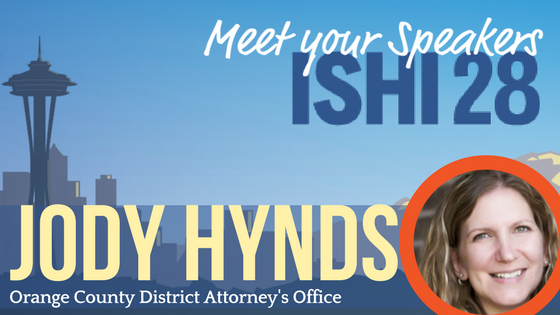The ISHI agenda is live and includes great talks from amazing speakers! While the forensic community is a tight-knit group, we can always get a little closer, right? With that in mind, we interviewed our speakers to preview their presentations and to get to know them a little better outside of their work. We’ve been posting their responses in a feature we like to call Under the Microscope.
Today, we’re chatting with Jody Hynds, who will be presenting The Need for Speed: Swiftly Solving Orange County Crime Utilizing Rapid Technology and the OCDA DNA Database along with Jennifer Contini during the General Sessions on Tuesday, October 3rd.
Why was the local DNA database program established in Orange County and what steps needed to be taken within the jurisdiction to allow for this?
The local OCDA DNA database was established to enhance the ability to accurately identify and prosecute the guilty and exonerate the innocent through the innovative, expeditious and ethical application of science and technology. OCDA utilizes California statute which permits law enforcement agencies to create a DNA databases.
Why did the OCDA decide to utilize a Rapid DNA instrument? What benefits does this instrument have over traditional DNA analysis?
OCDA is striving to harness and integrate the power of science and technology to promote justice and enhance public safety. The Rapid DNA instrument empowers law enforcement with investigative leads much faster than traditional means.
What process do you use to determine which samples are suitable for Rapid DNA and which should be sent to the lab for analysis?
The OCDA DNA Rapid Program only accepts blood, buccal, neat semen, gum and cigarette butts when there is sufficient quantity to submit a second sample to the crime lab for analysis and CODIS submission.
What advice can you offer other regions hoping to validate and implement a Rapid DNA instrument into their workflow?
A collaborative effort with the prosecutor’s office, crime laboratory and law enforcement agencies is critical for the successful implementation of this technology. . All agencies must understand the limitations of this technology.
What do you feel is the biggest challenge that forensics laboratories are facing today?
The tide of technology is changing and the legal system is a slow moving ship. Getting the new technology integrated in the daily life of the justice system by being one step ahead is difficult.
What do you think are likely to be the most exciting developments for the industry over the next couple of years?
NGS
What tips would you give to someone who is just starting out in the forensics field, or what’s the best advise you’ve ever received?
- Know your validations
- Stay curious
- Don’t be scared of testimony. It’s an integral part of the job. Embrace it.
How did you become interested in forensics?
I took a forensic anthropology course and found it fascinating. I fell into a forensic DNA internship in undergrad and never looked back.
When you’re not at work, what do you most enjoy doing?
Reading, crocheting whenever my 2 year old gives me the chance, kayaking.
For those who are on the fence about registering for the upcoming ISHI, please share your thoughts and reasons why they should attend.
If you go yearly, you start to recognize faces, and making professional contacts from all over the world. The best “best practices” meetings are the ones with great attendee diversity.
WOULD YOU LIKE TO SEE MORE ARTICLES LIKE THIS? SUBSCRIBE TO THE ISHI BLOG BELOW!


